Pre-Launch review of Craftel's New Amp and Speakers
In 1904, JA Fleming introduced the vacuum-tube diode. Shortly afterwards, in 1906, Lee De Forest added a third element called the control grid, resulting in the first amplifier, the triode. Audio devices were built using the vaccum-tube triode till 1947. On December 3, 1947, Walter H. Brattain and John Bardeen demonstrated the amplifying capabilities of a transistor. The transistor was a three terminal solid state device that had immediate advantages over the vacuum tube. It was smaller, lightweight, had no heating requirements, no heat loss, was rugged, and needed much less energy than the vacuum tube. It was instantly available for use with no warm up periods.
A conventional transistor has three terminals for connection to an external circuit. A voltage or current applied to one pair of terminals changes the current flowing through another pair of terminals. Since the output is much more than the input, the transistor provides the amplification of a signal.
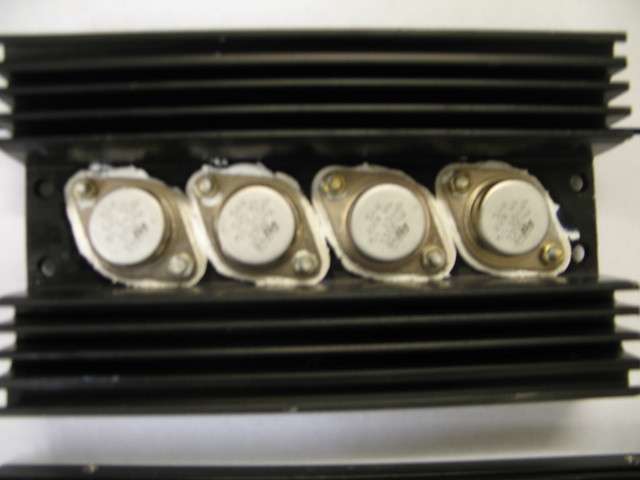
(Conventional transistors used by Craftel)
Conventional metal gate transistors are circular in shape, and have two small extensions on two sides for bolting onto a heat sink. The terminals come out at the bottom where the circuitry is implemented. Because of the amplification, transistors get extremely hot, and hence the need for heat sinks. There is certain size below which the metal transistors cannot be reduced. Thus the circuit boards have to be large to seat all the transistors and their related heat sinks during various stage of amplification.
In 1925, Julius Lilienfield proposed the use of semiconductors for switching and amplification purposes. Called the Metal-Oxide-Semiconductor Field Effect Transistor (or MOSFET), this is again a three terminal device used for switching, amplification, and other tasks. In MOSFETs, a voltage is applied on the oxide insulated gate electrode inducing a conducting channel between the other two contacts called source and drain.
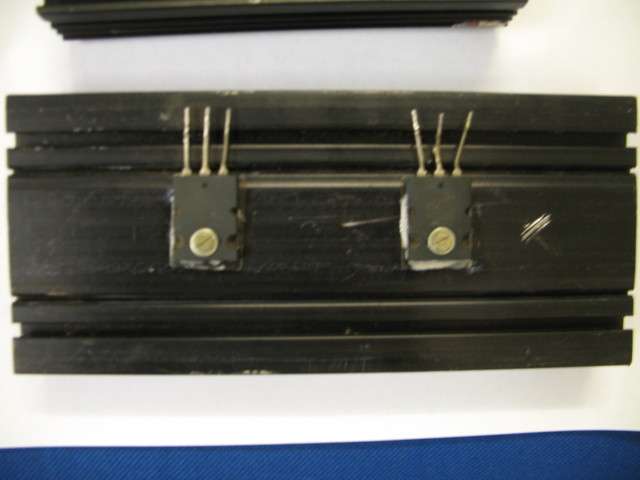
(MOSFET Transistors)
Since MOSFETs are made of silicon, their size has been reducing with time, allowing designers the option of incorporating hundreds of transistors in a small circuit board. Following Moores Law, MOSFETs have, between 1970 and 2000, been reduced in size by 13% year after year.
MOSFETs have three disadvantages. At the design level, because of their size, you are forced to use extremely high quality circuit boards as well as accessory parts. Since the volatage used by these MOSFETs are very tiny, the carriers used in the circuit boards have to have literally zero resistance. This shoots up the cost of design as well as production as you need specialized manufacturing facilities.
As the devices reduce in size, the electric field increases and the carriers in the channel have an increased velocity. As this goes up, there is no longer a linear relation between the electric field and velocity.
Thirdly, as the gate-oxide is scaled down, breakdown of the oxide and oxide reliability becomes a concern. Higher fields in the oxide increase the tunneling of carriers from the channels into the oxide. This leads to failure of oxide over time. Oxides other than silicon dioxide have and are being used. Called high-K dielectrics, these again push up the costs.
What do you do if you are small company with an interest in bringing out audio products at reasonable prices? What if you dont have the capability to design highly integrated circuits nor the manufacturing facility to produce these circuits? What if your volume of production does not justify these high costs?
Though the space required may be higher, why not go back to using metal-gate transistors? Why not mount the transistors in proper heat sinks and design an amplifier that way?
When I met Mark of Craftel over two years ago, he had demonstrated a number of his equipment to me. This included his car audio with a monstrous sub, his multi channel amp, his large floor standers, etc. During a detailed demo of his amplifier and speakers, I had come across a number of lacuna in the delivery and I had pointed out these to Mark. He had promised to remove the lacuna for me to do a second auditioning, but that never happened. Though the amplifier and speakers did deliver good value for the price, the combination was lacking in a number of areas. This has been discussed in detail in this thread - http://www.hifivision.com/surround-...aftel-dgl-5000-ht-amp-audiocraft-chennai.html. My advice to Mark was to make an amplifier speaker combination that is excellent VFM for budget audiophiles.
Murali has been in touch with Mark regularly and has been egging him to make a 2 channel amp and bookshelf speakers that speak well for themselves. With a bulk of his business coming from HT enthusiasts, Mark was skeptical in the beginning. At the same time, he has worked diligently over the last 12 months and the result is well worth the wait.
Enter the Craftel Retro 1100 amplifier and the Toga Reference bookshelf speakers.
Using unconventional wisdom, Mark has thrown out all rules and made a two channel amplifier using conventional metal gate transistors. The same size of regular two channel amps, the Retro 1100 pumps out 110 watts per channel into 6.5 ohms. The transistors are sourced from either ST Microelectronics or from BEL.

(One of control/pre amp stage circuit board)
The Retro1100 Integrated Amplifier
The amplifier supports two pairs of speakers, a pair of headphones, and has brass, treble, and balance controls. The amp has six inputs including Aux, DVD, CD, and Tape. It has a line out for recording purposes. All these are connected through conventional RCA sockets which have been chosen to keep costs down. But there is a caveat. Mark has also introduced a pair of high grade gold plated RCA sockets that can be used with a CD player for listening to music. These terminals do not go through any switch, but are directly soldered to the pre-amp gain section. Based on your requirements, these terminals will eat up one of the other terminals. In other words, if you choose to use these terminals for CD, the regular CD socket will not work.
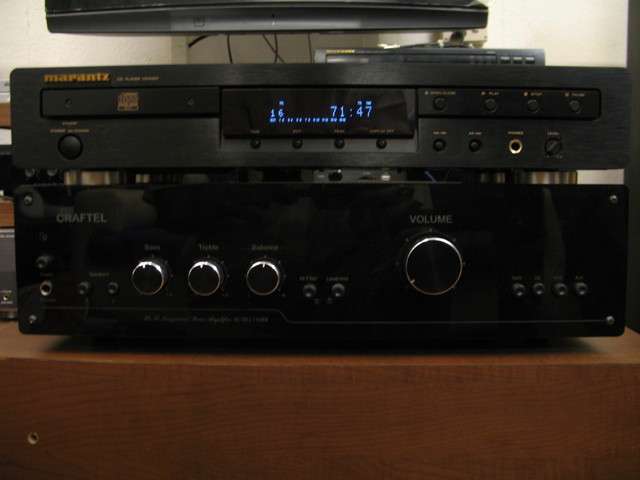
(A front view of the Retro 1100)

(Side view)
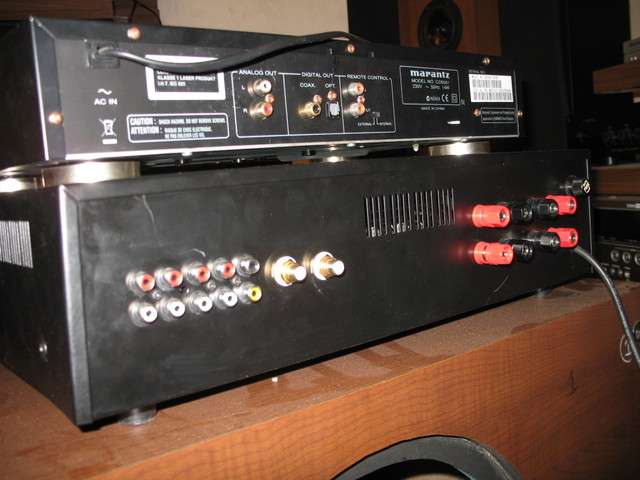
(Rear view of the Retro1100
The amplifier also has a HiFi Filter to be used with turntables. This cuts of all signals above 16kHz, essentially cutting off the irritating scratch noises of vinyl albums. There is also a loudness button that truncates very low frequencies and very high frequencies. My guess is less than 50Hz at the lower end, and more than 16kHz at the high end. This is only a guess. The advantage is that you will hear the mid frequencies with greater clarity.
The Retro 1100 is a Class AB integrated that switches from A to B at around 20 watts. Mark prefers to say that the switching is done in stage three out of a total of 5 stage amplification.
The Bookshelf Speakers
The bookshelf speakers are called Toga Reference. There are two versions available. One is the standard rear firing ported speakers, and the other is front bass reflex ported. The speakers have a dimension of 7" x12" x14" (w-h-d). The drivers, according to Mark, has been made specially for Craftel and the LF and HF drivers have been matched for each pair. They come marked as a pair, and if one of the drivers is damaged, the whole pair has to be set aside. The HF driver is a silk dome tweeter made from non resonant poly carbonate body with flare. The LF driver is a 5-1/2" titanium cone woofer designed with rubber surrounds and a spider (M-Series) for controlled excursion. The voice coil rests on an aluminium frame with side ports on the basket for cooling
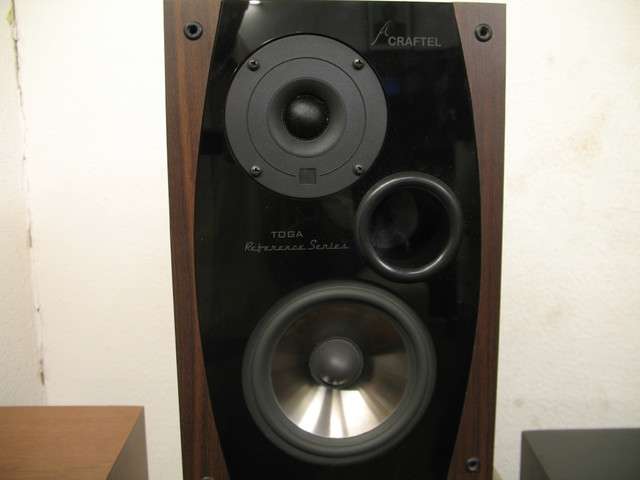
(Front view of the Toga Reference)
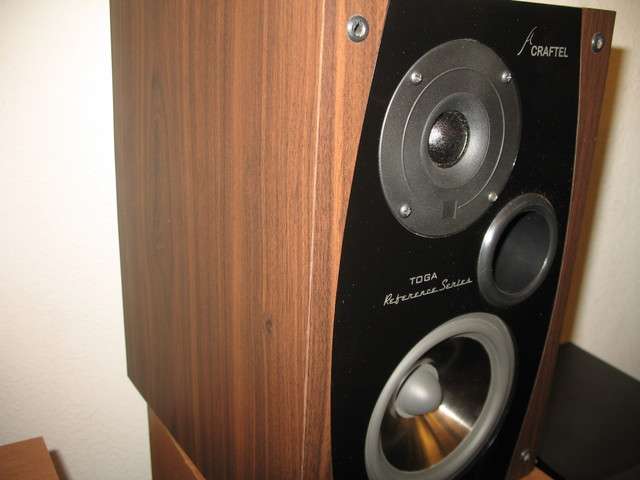
(Another front view)
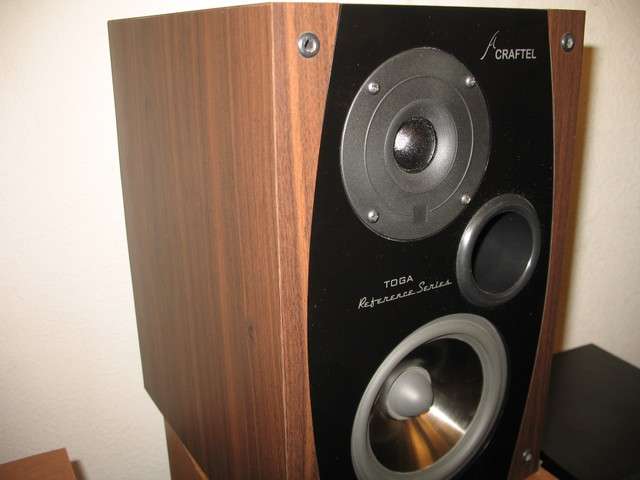
(Another view)

(The rear of the Toga Reference with Mark holding it in his hand for size reference)
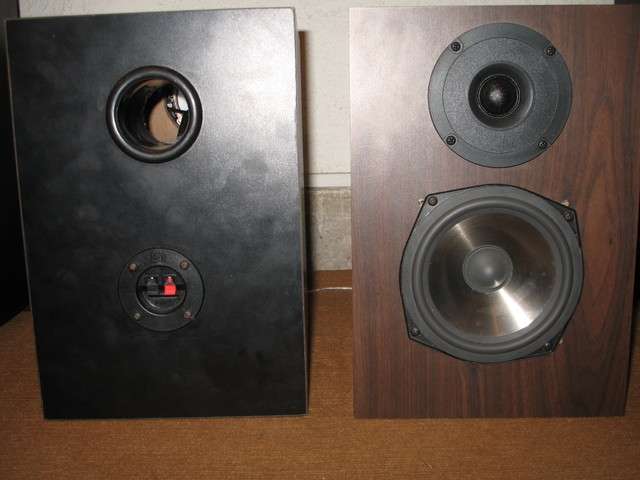
(The Toga rear firing ported speakers with combined front and rear views)
The speakers are rated at 75 watts into 4 ohms. They are magnetically shielded, meaning they can be kept next to your TV. They have a high sensitivity of 91.2 db. The cabinet is made of 3-1/4" MDF with twin layer front panel.
The speaker specifications match well with those of the amp.
The amp was connected to the speakers with a 16AWG Belden cable terminated with gold plated banana plugs at the amp end. At the speaker end, the cables were connected using bare wires.
Mark used a Marantz 5001 CD Player. This was connected to the amp using a RG28 ICs terminated with Nuetrik banana plugs. The RG28 is used for professional equipment, has 19 strands of tinned copper with 34 AWG tinned copper braid shield and 34 AWG galvanized steel shield. The dielectric as well as the outer shielding is rubber.
Performance
Mark played Improvisation' by Ron Tutt from Focal Audios demo disk. I was immediately blown away by the large soundstage created by the combination as well as the tightness of the drums. Mark had placed the Togas over a pair of very large floor standers, and I had to take a peek at the back. It was indeed the Togas that were playing. Has Mark made a standards changing amp/speaker combination?
After listening to Improvisation, I played Sacred Sound from Raga Symphony and Nine Million Bicycles by Katie Meluah. In Sacred Sound I was hoping to be transformed to a different world, but was disappointed. The soundstage was missing, and because the speakers were on a very high pedestal, the sound seemed to flow over my head. There was obvious muddling in the mid frequencies as I could not hear the tanpuras that kept the rhythm for the orchestra. In Nine Billion Bicycles, Katies voice was very high pitched, and not musical at all. I had heard Piece By Piece only two days ago, and her voice, her musicality, and the soundstage was floating in my mind. I knew where the issue was but wanted to be sure. I listened to Famous Groupies and Deliver Your Children from Paul McCartneys London Town, and my doubts were getting more solid. In the first stanza of Famous Groupies, when Paul starts with there was a bongo player.. the drums play a low amplitude rhythm at the back. The guitar also sounds as if the strings are loose. In the Retro 1100/Toga combination, the drums were muted and the twang of the guitars was missing. In addition, at the end, there is the sound of a few seagulls screaming overhead. In this system they sounded more like humans screaming.
I shut down the system, and replaced Marks IC with my own AR Performance series balanced line cable. When I inserted Raga Symphony again, the music opened up and I could hear all the instruments clearly. The tanpuras were there, as were the musicality of the voices, and the instruments. What was missing was the large soundstage I am used to, but that was something I was not expecting from this system.
I inserted Katie Meluah, and immediately the melody in her voice was audible. In the album Piece by Piece, the editor has created a short echo of Katies voice when she ends a line, and this echo is always ended abruptly. This was delivered faithfully by the system, though the system was yet a little high pitched for my ears. I am sure Mark would adjust that in the delivery models.
In London Town, I re-heard Children Children, Famous Groupies, Deliver Your Children, and Mull Of Kintyre. At the end of Famous Groupies, the seagulls were seagulls, and the drums were tight and audible.
I continued my audition with a number of tracks from other albums including Shankar Mahadevans Breathless, The Essential Neil Diamond, and Varnam Aayiram. At the fag end of the audition we were joined by Murali. We tried changing the speaker cables with my own 14AWG Belden. Murali also realized that the AR cable was directional. So we shut down the system, ensured the direction was correct, and played most of the tracks.
The Retro1100/Toga combination delivers far beyond its value. There is no doubt in my mind. Is it competitive to high end systems? Certainly not, as long as you know what to expect from the system. If you want tight base, a good mid range, clarity, and fatigue free listening, this combination is your answer.
I would like to hear the amp with other speakers, and the speaker with other amps. But for what Mark is expecting to sell these systems at, I believe they do deliver great VFM.
Let us do a little calculation:
1. Amp - 15K
2. Speaker Pair - 15K
3. IC - 1.5K
4. Speaker Cables - 2K
5. CD Player - 15K
[Important Note. The prices of the amp and speaker pair are just my guesstimates. I understand Mark is looking at pricing these at around 12K each. ]
For between 40 and 50K, you can get a real musical system that will play western instrumental, vocal, Indian film songs, and rock quite well. I have to hear the system for western classical as well do some serious listening to Indian instrumental classicals. But since the system fares well with western instruments, I reckon it will play Indian classical also quite well.
Conclusion
Do I dare to call this a budgetary audiophile system? Maybe, but with a number of caveats.
Mark has to make a number of improvements in the amplifier. The speaker terminals at the back are paired horizontally. They have to be paired vertically. A remote control will be nice, but that will push the prize, and make it an unviable value proposition.
All told, I think Mark has excelled himself and created a really good budgetary system. The Retro 1100/Toga combination is a must audition for anyone who is planning for a two channel music system that does not break the bank.
Well done Mark.
Cheers
In 1904, JA Fleming introduced the vacuum-tube diode. Shortly afterwards, in 1906, Lee De Forest added a third element called the control grid, resulting in the first amplifier, the triode. Audio devices were built using the vaccum-tube triode till 1947. On December 3, 1947, Walter H. Brattain and John Bardeen demonstrated the amplifying capabilities of a transistor. The transistor was a three terminal solid state device that had immediate advantages over the vacuum tube. It was smaller, lightweight, had no heating requirements, no heat loss, was rugged, and needed much less energy than the vacuum tube. It was instantly available for use with no warm up periods.
A conventional transistor has three terminals for connection to an external circuit. A voltage or current applied to one pair of terminals changes the current flowing through another pair of terminals. Since the output is much more than the input, the transistor provides the amplification of a signal.

(Conventional transistors used by Craftel)
Conventional metal gate transistors are circular in shape, and have two small extensions on two sides for bolting onto a heat sink. The terminals come out at the bottom where the circuitry is implemented. Because of the amplification, transistors get extremely hot, and hence the need for heat sinks. There is certain size below which the metal transistors cannot be reduced. Thus the circuit boards have to be large to seat all the transistors and their related heat sinks during various stage of amplification.
In 1925, Julius Lilienfield proposed the use of semiconductors for switching and amplification purposes. Called the Metal-Oxide-Semiconductor Field Effect Transistor (or MOSFET), this is again a three terminal device used for switching, amplification, and other tasks. In MOSFETs, a voltage is applied on the oxide insulated gate electrode inducing a conducting channel between the other two contacts called source and drain.

(MOSFET Transistors)
Since MOSFETs are made of silicon, their size has been reducing with time, allowing designers the option of incorporating hundreds of transistors in a small circuit board. Following Moores Law, MOSFETs have, between 1970 and 2000, been reduced in size by 13% year after year.
MOSFETs have three disadvantages. At the design level, because of their size, you are forced to use extremely high quality circuit boards as well as accessory parts. Since the volatage used by these MOSFETs are very tiny, the carriers used in the circuit boards have to have literally zero resistance. This shoots up the cost of design as well as production as you need specialized manufacturing facilities.
As the devices reduce in size, the electric field increases and the carriers in the channel have an increased velocity. As this goes up, there is no longer a linear relation between the electric field and velocity.
Thirdly, as the gate-oxide is scaled down, breakdown of the oxide and oxide reliability becomes a concern. Higher fields in the oxide increase the tunneling of carriers from the channels into the oxide. This leads to failure of oxide over time. Oxides other than silicon dioxide have and are being used. Called high-K dielectrics, these again push up the costs.
What do you do if you are small company with an interest in bringing out audio products at reasonable prices? What if you dont have the capability to design highly integrated circuits nor the manufacturing facility to produce these circuits? What if your volume of production does not justify these high costs?
Though the space required may be higher, why not go back to using metal-gate transistors? Why not mount the transistors in proper heat sinks and design an amplifier that way?
When I met Mark of Craftel over two years ago, he had demonstrated a number of his equipment to me. This included his car audio with a monstrous sub, his multi channel amp, his large floor standers, etc. During a detailed demo of his amplifier and speakers, I had come across a number of lacuna in the delivery and I had pointed out these to Mark. He had promised to remove the lacuna for me to do a second auditioning, but that never happened. Though the amplifier and speakers did deliver good value for the price, the combination was lacking in a number of areas. This has been discussed in detail in this thread - http://www.hifivision.com/surround-...aftel-dgl-5000-ht-amp-audiocraft-chennai.html. My advice to Mark was to make an amplifier speaker combination that is excellent VFM for budget audiophiles.
Murali has been in touch with Mark regularly and has been egging him to make a 2 channel amp and bookshelf speakers that speak well for themselves. With a bulk of his business coming from HT enthusiasts, Mark was skeptical in the beginning. At the same time, he has worked diligently over the last 12 months and the result is well worth the wait.
Enter the Craftel Retro 1100 amplifier and the Toga Reference bookshelf speakers.
Using unconventional wisdom, Mark has thrown out all rules and made a two channel amplifier using conventional metal gate transistors. The same size of regular two channel amps, the Retro 1100 pumps out 110 watts per channel into 6.5 ohms. The transistors are sourced from either ST Microelectronics or from BEL.

(One of control/pre amp stage circuit board)
The Retro1100 Integrated Amplifier
The amplifier supports two pairs of speakers, a pair of headphones, and has brass, treble, and balance controls. The amp has six inputs including Aux, DVD, CD, and Tape. It has a line out for recording purposes. All these are connected through conventional RCA sockets which have been chosen to keep costs down. But there is a caveat. Mark has also introduced a pair of high grade gold plated RCA sockets that can be used with a CD player for listening to music. These terminals do not go through any switch, but are directly soldered to the pre-amp gain section. Based on your requirements, these terminals will eat up one of the other terminals. In other words, if you choose to use these terminals for CD, the regular CD socket will not work.

(A front view of the Retro 1100)

(Side view)

(Rear view of the Retro1100
The amplifier also has a HiFi Filter to be used with turntables. This cuts of all signals above 16kHz, essentially cutting off the irritating scratch noises of vinyl albums. There is also a loudness button that truncates very low frequencies and very high frequencies. My guess is less than 50Hz at the lower end, and more than 16kHz at the high end. This is only a guess. The advantage is that you will hear the mid frequencies with greater clarity.
The Retro 1100 is a Class AB integrated that switches from A to B at around 20 watts. Mark prefers to say that the switching is done in stage three out of a total of 5 stage amplification.
The Bookshelf Speakers
The bookshelf speakers are called Toga Reference. There are two versions available. One is the standard rear firing ported speakers, and the other is front bass reflex ported. The speakers have a dimension of 7" x12" x14" (w-h-d). The drivers, according to Mark, has been made specially for Craftel and the LF and HF drivers have been matched for each pair. They come marked as a pair, and if one of the drivers is damaged, the whole pair has to be set aside. The HF driver is a silk dome tweeter made from non resonant poly carbonate body with flare. The LF driver is a 5-1/2" titanium cone woofer designed with rubber surrounds and a spider (M-Series) for controlled excursion. The voice coil rests on an aluminium frame with side ports on the basket for cooling

(Front view of the Toga Reference)

(Another front view)

(Another view)

(The rear of the Toga Reference with Mark holding it in his hand for size reference)

(The Toga rear firing ported speakers with combined front and rear views)
The speakers are rated at 75 watts into 4 ohms. They are magnetically shielded, meaning they can be kept next to your TV. They have a high sensitivity of 91.2 db. The cabinet is made of 3-1/4" MDF with twin layer front panel.
The speaker specifications match well with those of the amp.
The amp was connected to the speakers with a 16AWG Belden cable terminated with gold plated banana plugs at the amp end. At the speaker end, the cables were connected using bare wires.
Mark used a Marantz 5001 CD Player. This was connected to the amp using a RG28 ICs terminated with Nuetrik banana plugs. The RG28 is used for professional equipment, has 19 strands of tinned copper with 34 AWG tinned copper braid shield and 34 AWG galvanized steel shield. The dielectric as well as the outer shielding is rubber.
Performance
Mark played Improvisation' by Ron Tutt from Focal Audios demo disk. I was immediately blown away by the large soundstage created by the combination as well as the tightness of the drums. Mark had placed the Togas over a pair of very large floor standers, and I had to take a peek at the back. It was indeed the Togas that were playing. Has Mark made a standards changing amp/speaker combination?
After listening to Improvisation, I played Sacred Sound from Raga Symphony and Nine Million Bicycles by Katie Meluah. In Sacred Sound I was hoping to be transformed to a different world, but was disappointed. The soundstage was missing, and because the speakers were on a very high pedestal, the sound seemed to flow over my head. There was obvious muddling in the mid frequencies as I could not hear the tanpuras that kept the rhythm for the orchestra. In Nine Billion Bicycles, Katies voice was very high pitched, and not musical at all. I had heard Piece By Piece only two days ago, and her voice, her musicality, and the soundstage was floating in my mind. I knew where the issue was but wanted to be sure. I listened to Famous Groupies and Deliver Your Children from Paul McCartneys London Town, and my doubts were getting more solid. In the first stanza of Famous Groupies, when Paul starts with there was a bongo player.. the drums play a low amplitude rhythm at the back. The guitar also sounds as if the strings are loose. In the Retro 1100/Toga combination, the drums were muted and the twang of the guitars was missing. In addition, at the end, there is the sound of a few seagulls screaming overhead. In this system they sounded more like humans screaming.
I shut down the system, and replaced Marks IC with my own AR Performance series balanced line cable. When I inserted Raga Symphony again, the music opened up and I could hear all the instruments clearly. The tanpuras were there, as were the musicality of the voices, and the instruments. What was missing was the large soundstage I am used to, but that was something I was not expecting from this system.
I inserted Katie Meluah, and immediately the melody in her voice was audible. In the album Piece by Piece, the editor has created a short echo of Katies voice when she ends a line, and this echo is always ended abruptly. This was delivered faithfully by the system, though the system was yet a little high pitched for my ears. I am sure Mark would adjust that in the delivery models.
In London Town, I re-heard Children Children, Famous Groupies, Deliver Your Children, and Mull Of Kintyre. At the end of Famous Groupies, the seagulls were seagulls, and the drums were tight and audible.
I continued my audition with a number of tracks from other albums including Shankar Mahadevans Breathless, The Essential Neil Diamond, and Varnam Aayiram. At the fag end of the audition we were joined by Murali. We tried changing the speaker cables with my own 14AWG Belden. Murali also realized that the AR cable was directional. So we shut down the system, ensured the direction was correct, and played most of the tracks.
The Retro1100/Toga combination delivers far beyond its value. There is no doubt in my mind. Is it competitive to high end systems? Certainly not, as long as you know what to expect from the system. If you want tight base, a good mid range, clarity, and fatigue free listening, this combination is your answer.
I would like to hear the amp with other speakers, and the speaker with other amps. But for what Mark is expecting to sell these systems at, I believe they do deliver great VFM.
Let us do a little calculation:
1. Amp - 15K
2. Speaker Pair - 15K
3. IC - 1.5K
4. Speaker Cables - 2K
5. CD Player - 15K
[Important Note. The prices of the amp and speaker pair are just my guesstimates. I understand Mark is looking at pricing these at around 12K each. ]
For between 40 and 50K, you can get a real musical system that will play western instrumental, vocal, Indian film songs, and rock quite well. I have to hear the system for western classical as well do some serious listening to Indian instrumental classicals. But since the system fares well with western instruments, I reckon it will play Indian classical also quite well.
Conclusion
Do I dare to call this a budgetary audiophile system? Maybe, but with a number of caveats.
- You need to use a good quality CD player with quality DAC inside.
- The Retro1100 is purely analog and all digital processing has to be done outside.
- You have to get decent IC as well as good speaker cables.
- Depending upon your hearing pattern, you might have to ask Mark to, for example, tone down the high frequencies. Some may find the tight bass a little hurting in their chest.
- The speakers would need good stands or a solid shelf to sit on. The front baffle pumps out large amount of airs, and the LF driver moves like crazy. They need a solid ground to sit on.
- Inspite of the stated wattage, this system will work well for a small room, with a maximum floor area of about 250-300 sq. feet.
Mark has to make a number of improvements in the amplifier. The speaker terminals at the back are paired horizontally. They have to be paired vertically. A remote control will be nice, but that will push the prize, and make it an unviable value proposition.
All told, I think Mark has excelled himself and created a really good budgetary system. The Retro 1100/Toga combination is a must audition for anyone who is planning for a two channel music system that does not break the bank.
Well done Mark.
Cheers
Last edited:

